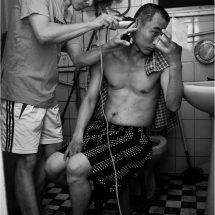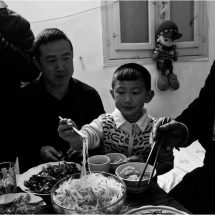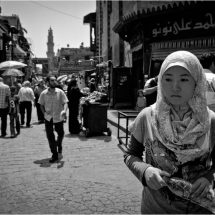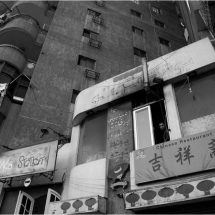Kim Badawi
June 7, 2012
French-American freelance photojournalist and portrait photographer.
Biography
He began his career photographing the plight of refugee families from Mississippi to Texas in the aftermath of Hurricane Katrina.
His work in photography has taken him to all parts of Europe, North America, the Caribbean, Brazil, and the Middle East where he has documented the “Arab Spring.”
Selected for publication by the Center for Documentary Studies at Duke University, Kim Badawi’s work appears in 25 Under 25: Up-and-Coming American Photographers (powerHouse Books, 2008).
You can see part of his work here bellow in the media gallery or here.
Interview
Why does immigration reporting matter today?
Immigration helps shape the cultural landscape of tomorrow’s world. As I bear witness, I feel the obligation to document it.My grandmother was born in a small village in the Alps, called Prvacina. She was born Austrian, but over the next 30 years, the men in her village would be given four different army uniforms. So at a time when maps were being re-drawn, frontiers were being changed and borders blurred, my grandmother traveled by boat from her native, small agricultural village, in present day Slovenia to the bustling and culturally flourishing city of Alexandria, Egypt. Arriving initially as a migrant worker, she eventually married an Egyptian engineer working on the Suez Canal and so she settled in Egypt. My grandmother was not the only young nurse to leave for Egypt. In fact, over 50,000 women made the journey as well, as documented in the award winning film The Alexandrians (Alexandrinke-2011), by Metod Pevec. The film gives countless reports of this life-altering decision, and a brief interview with my own mother is featured in the documentary.
What makes an outstanding reporter?
Luckily, I have had the opportunity to work alongside many world-renowned journalists over the past few years. I learn so much by watching other journalists in the field, whether in broadcast, print, photography or radio—all practicing the art of story telling. Most interesting perhaps are the times when we are all working to define the same story.
During the first eighteen days of the Egyptian uprising, I was working as a photographer for CNN. Despite our crew being attacked by mobs of pro-government supporters, I was baffled by how time and time again, reporters such as Anderson Cooper would set out armed with only a microphone and a camera in an attempt to gather interviews. Some of the people he interviewed would be hysterical and go off ranting on tangent subjects. Despite this, with every new interview, Anderson Cooper would start fresh, remaining calm and unshaken by the previous interview.
Who are your inspirations in journalism?
I am inspired by a myriad of journalists and story-tellers alike.
Some inspirations include: Henri Cartier-Bresson, Elijah Parish Lovejoy, Vasily Grossman, Wilfred Burchett, Jacob Riis, Antony Shadid, Joesph Koudelka, Dominique deSanti, Eddie Adams, Emile Zola, Peter Arnett, Chien-Chi Chang, Mathew Brady, Jon Stewart, Hunter S. Thompson, Herve Guibert, Margaret Bourke-White, Eugene Smith, Dorothea Lange, Benjamin Franklin, Julian Assange, Joshua Micah Marshall, Norbert Zongo, James Nachtwey, Neil Davis, Kevin Carter, Damien Parer, David Rieff, Hendrik Hertzberg, Theophile Gautier, Jean Paul Marat, Charlie Rose, Bernard Pivot, Nawal El Saadawi, Mona Eltahawy, Mahmoud Salem (also known by his blogger name “Sand Monkey”), and Tintin by Hergé.
And finally, a quotation that I believe holds true:
“I find it interesting, the different rules that apply to journalism and drama, even though journalism has become more and more about entertainment, and entertainment has become more and more about journalism. “ – Gus Van Sant.
While on the ground, what is your most memorable anecdote?
I like to think that because I take photographs, I generally don’t have to share anecdotes, but strangely enough, some of my most memorable anecdotes are from moments when I don’t have a camera handy or am in between rolls of film.
In the evening of February 10, 2011, I was taking photos in the now mythical Tahrir Square. Former Egyptian president Hosni Mubarak’s televised address had infuriated the thousands of people in the square, and they vowed that the time for Revolution had come, and it was now or never. I watched as hundreds of trained men jogged endlessly in circles, chanting throughout the night. In a scene that looked like it could have been straight out of the French Revolution, I decided to join the first group as they left Tahrir Square to march to the presidential palace at daybreak. Less than twelve hours later Mubarak would step down and Egypt would be free.
As the frontline of protesters approached the palace, adrenaline rose as the rows of soldiers and tanks appeared. As we brushed the barbed wire, the first soldiers came face to face with the revolutionaries. But no one struck first, and there was a stand-off. Hours passed, and by mid-day the crowds had grown phenomenal in size. As I stood changing my lens or card (I don’t recall which one), one of the numerous street children on the side of the protesters recognized a soldier from his neighborhood and dashed up to hug him. I stared baffled as the two embraced tightly facing the sky, both smiling. At that moment, I knew that the revolution would be a triumph.
What are your next projects?
A story about racism in Kyrgyzstan. After that I will be relocating to Brazil by 2013, at the latest.
What resources would you recommend on the topic? (articles, websites, video, movies, books, etc.)
Articles:
Personally, I always prefer to receive information visually. Maps and graphs are often the best resources to understand numbers on a global scale.
Many of the following articles, books and links make use of interactive maps or graphs.
Some may not be specifically about immigration but touch upon issues that in many cases directly influence migratory trends.
L’Atlas 2013, published by Le Monde Diplomatique, here.
“The Immigrant Explorer” Interactive Map, created by the New York Time, here.
People on the Move: An Atlas of Migration, by Russell King
International Migration in the Age of Crisis and Globalization, by Dr Andes Solimano
Population Geography: Tools and Issues, by K. Bruce Newbold
Websites :
Migrations Map, here.
The Migration Policy Institute, here.
Human Development Reports, here.




